
In military organizations, a colour guard is a detachment of soldiers assigned to the protection of regimental colours and the national flag. This duty is highly prestigious, and the military colour is generally carried by a young officer (ensign), while experienced non-commissioned officers are assigned to the protection of the national flag. These non-commissioned officers, accompanied in several countries by warrant officers, can be ceremonially armed with either sabres or rifles to protect the colour. Colour guards are generally dismounted, but there are also mounted colour guard formations as well.
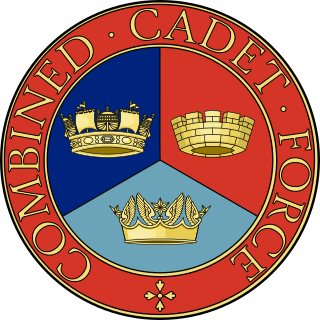
The Combined Cadet Force (CCF) is a youth organisation in the United Kingdom, sponsored by the Ministry of Defence (MOD), which operates in schools, sub divided into Royal Navy, Royal Marines, Army and Royal Air Force sections. Its aim is to "provide a disciplined organisation in a school so that pupils may develop powers of leadership by means of training to promote the qualities of responsibility, self reliance, resourcefulness, endurance and perseverance".
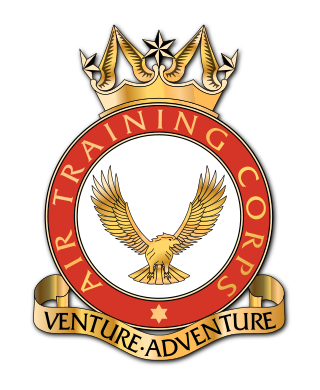
The Air Training Corps (ATC) is a British volunteer youth organisation of the United Kingdom; aligned to, and fostering the knowledge and learning of military values, primarily focussing on military aviation. Part of the Royal Air Force Air Cadets (RAFAC), the ATC is sponsored by the Royal Air Force (RAF) and the wider Ministry of Defence (MoD). The majority of Air Training Corps staff are volunteers, though some staff are paid for full-time work; including Commandant Air Cadets, who is a Royal Air Force officer as part of a Full Term Reserve Service commitment.
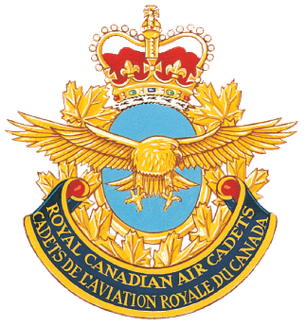
The Royal Canadian Air Cadets is a Canadian national youth program for young individuals aged 12 to 19. Under the authority of the National Defence Act, the program is administered by the Canadian Forces (CF) and funded through the Department of National Defence (DND). Additional support is provided by the civilian Air Cadet League of Canada (ACLC). Together with the Royal Canadian Sea Cadets and Royal Canadian Army Cadets, it forms the "largest federally funded youth program in the country". Cadets are not members of the military and are not obliged to join the Canadian Forces.
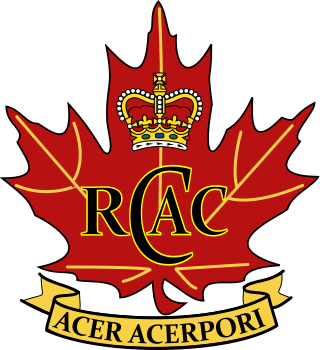
The Royal Canadian Army Cadets is a national Canadian youth program sponsored by the Canadian Armed Forces and the civilian Army Cadet League of Canada. Under the authority of the National Defence Act, the program is administered by the Canadian Armed Forces and funded through the Department of National Defence. Additionally, the civilian partner of the Royal Canadian Army Cadets, the Army Cadet League of Canada, also ensures financial, accommodations and transportation support for RCAC programs and services at a community level.

The King's Colour Squadron, formerly the Queen's Colour Squadron, is the unit of the Royal Air Force charged with the safe-keeping of the King's Colour for the Royal Air Force in the United Kingdom. Since its formation, it has been formed exclusively by Officers and Gunners of No. 63 Squadron RAF Regiment.

The New Zealand Air Training Corps is one of the three corps in the New Zealand Cadet Forces (NZCF), alongside the New Zealand Sea Cadet Corps and the New Zealand Cadet Corps. It is funded in partnership between the Royal New Zealand Air Force (RNZAF) and local communities. Members are civilians with no obligation to enlist in the New Zealand Defence Force (NZDF). Should a cadet enlist, their service in the ATC cadet does not translate into higher pay, rank, or seniority.

The Australian Air League (AAL) is a not-for-profit, civilian operated aviation youth organisation in Australia. Its objective is to encourage the spirit of aviation and air-mindedness in the youth of Australia. The Australian Air League receives no money or assistance of any government department and is entirely self-funded. Its Latin motto is A Vinculo Terrae. The official patron of the Australian Air League is aviation journalist Jeff Watson.
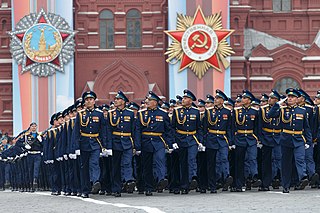
Full dress uniform, also known as a ceremonial dress uniform or parade dress uniform, is the most formal type of uniforms used by military, police, fire and other public uniformed services for official parades, ceremonies, and receptions, including private ones such as marriages and funerals. Full dress uniforms typically include full-size orders and medals insignia. Styles tend to originate from 19th century uniforms, although the 20th century saw the adoption of mess dress-styled full-dress uniforms. Designs may depend on regiment or service branch. In Western dress codes, full dress uniform is a permitted supplementary alternative equivalent to the civilian white tie for evening wear or morning dress for day wear – sometimes collectively called full dress – although military uniforms are the same for day and evening wear. As such, full dress uniform is the most formal uniform, followed by the mess dress uniform.
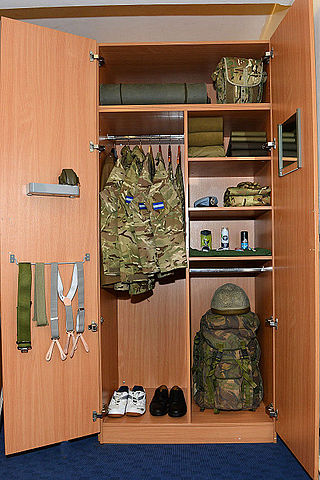
The uniforms of the British Army currently exist in twelve categories ranging from ceremonial uniforms to combat dress. Uniforms in the British Army are specific to the regiment to which a soldier belongs. Full dress presents the most differentiation between units, and there are fewer regimental distinctions between ceremonial dress, service dress, barrack dress and combat dress, though a level of regimental distinction runs throughout.
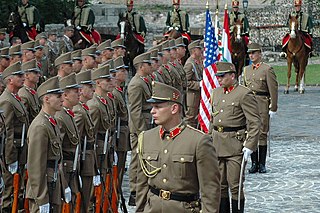
A guard of honour, honor guard or ceremonial guard, is a group of people, typically drawn from the military, appointed to perform ceremonial duties – for example, to receive or guard a head of state or other dignitaries, the fallen in war, or to attend at state ceremonials, especially funerals. In military weddings, especially those of commissioned officers, a guard, composed usually of service members of the same branch, form the sabre arch. In principle, any military unit could act as a guard of honour. However, in some countries, certain units are specially assigned to undertake guard of honour postings or other public duties. Republican guards, royal guards and foot guards frequently have ceremonial duties assigned to them.

The Australian Army Cadets (AAC) is the youth military program and organisation of the Australian Army, tasked with supporting participants to contribute to society, fostering interest in defence force careers, and developing support for the forces. The program has more than 19,000 army cadets between the ages of 12 and 20 based in more than 200 units around Australia. The values of the AAC are "Service, Courage, Respect, Integrity and Excellence".
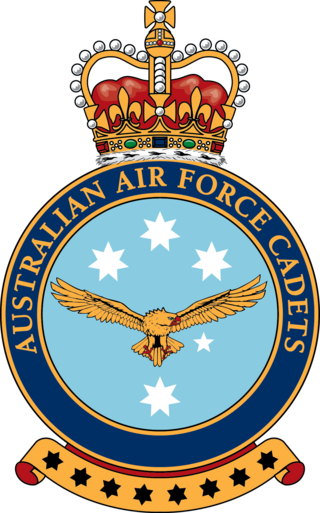
The Australian Air Force Cadets (AAFC), known as the Air Training Corps (AIRTC) until 2001, is a Federal Government funded youth organisation. The parent force of the AAFC is the Royal Australian Air Force (RAAF). Along with the Australian Army Cadets (AAC) and the Australian Navy Cadets (ANC), it is part of the Australian Defence Force Cadets.
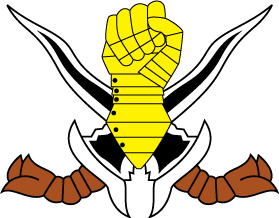
The Royal Armoured Corps or Kor Armor Diraja (KAD) is the armoured forces of the Malaysian Army.
The No.3 Squadron (Cobras) of the Indian Air Force (IAF) operates as a Close Air Support (CAS) and reconnaissance unit. Currently based at NAL Air Force Station, No. 3 Sqn falls under the Western Air Command, forms the 46 wing of the IAF.

The Hong Kong Air Cadet Corps is a voluntary uniformed group subsidised by the Home Affairs Bureau of the Hong Kong government and is registered under the Societies Ordinance as a non-profit making charitable organisation.
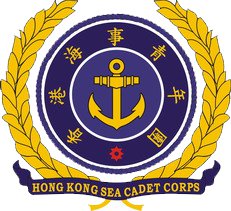
Hong Kong Sea Cadet Corps is a youth organization based in Hong Kong and formed in 1968 by former Royal Naval Reserve officers by the creation of Hong Kong Law
The Hong Kong Adventure Corps is a voluntary uniformed group subsidised by the Hong Kong government and the Hong Kong Jockey Club. It was created in 1995 with ties to the British Army's Army Cadet Force and Combined Cadet Force. Like the Hong Kong Sea Cadet Corps and Hong Kong Air Cadet Corps, the HKAC exists to serve the Hong Kong community. The HKAC's values are based in those of the British Army, providing a tough and challenging training with a distinctive military tone of discipline and esprit de corps.

A drum major in the military is the individual leading a military band or a field unit. It is an appointment, not a military rank. Military drum majors utilize a ceremonial mace for giving commands while marching. Many drum majors, particularly American- or British-influenced ones, wear a sash that can carry embroidered badges of their home unit and battle honors; a pair of ceremonial drum sticks are often attached.
The 2784 Governor General's Foot Guards Royal Canadian Army Cadet Corps is an Ottawa-based paramilitary youth program jointly-sponsored by the Canadian Forces and the Army Cadet League of Canada. The cadets, as their name implies, are affiliated with the Governor General's Foot Guards (GGFG), which is one of three Royal Household Division regiments in the Canadian Army. As an affiliated unit, the cadets may wear the badges of the GGFG. The cadet corps currently parade at Cartier Square Drill Hall alongside their GGFG counterparts and The Cameron Highlanders of Ottawa.

















